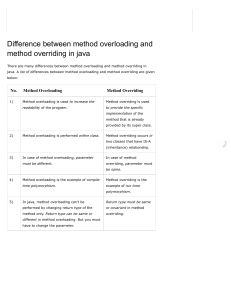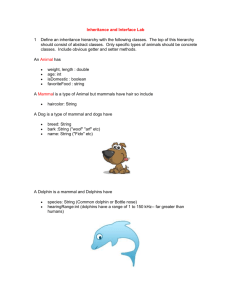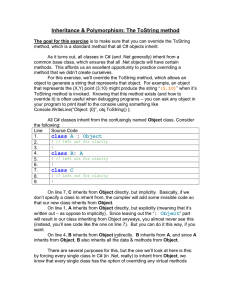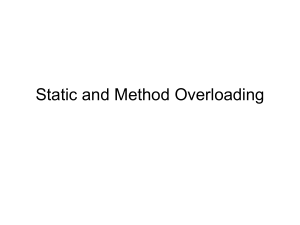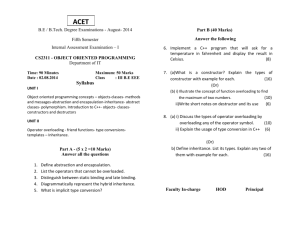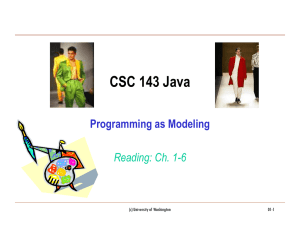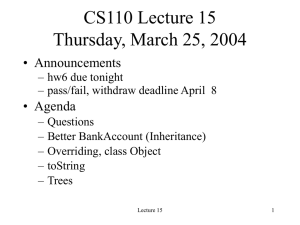CSC 143 Java Inheritance Tidbits (c) University of Washington 06-1
advertisement
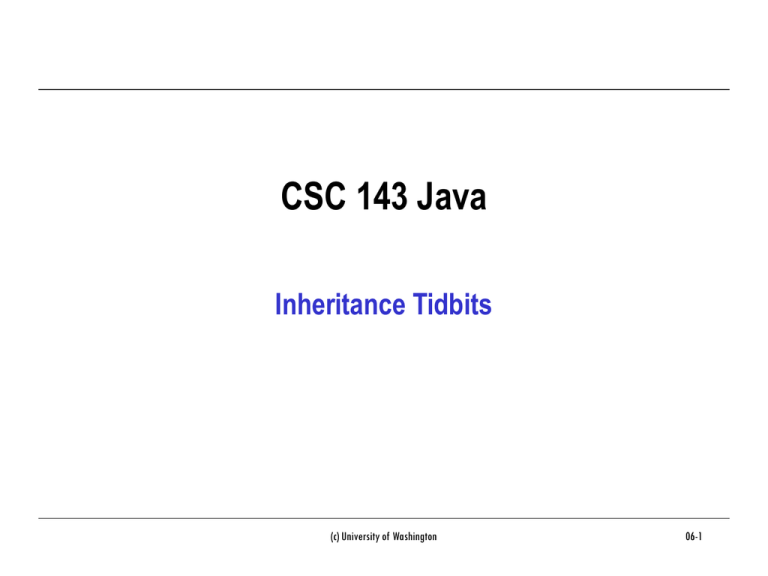
CSC 143 Java
Inheritance Tidbits
(c) University of Washington
06-1
Overview
• An assortment of topics related to inheritance
• Object class
• toString etc.
• instanceof, getClass()
• Overloading and overriding
(c) University of Washington
06-2
Inheritance Reviewed
• A class can be defined as an extension another one
• Inherits all behavior (methods) and state (instance variables) from
superclass
• (But only has direct access to public or protected
methods/variables)
• Use to factor common behavior/state into classes that can
be extended/specialized as needed
• Useful design technique: find a class that is close to what
you want, then extend it and override methods that aren’t
quite what you need
(c) University of Washington
06-3
Class Object
• In Java’s class model, every class directly or indirectly
extends Object, even if not explicitly declared
class Foo { … }
has the same meaning as class Foo extends Object { … }
• Class Object
• is the root of the class hierarchy
• contains a small number of methods which every class inherits and
which can be invoked on any object (mostly...)
toString( ), equals(Object), clone( ), hashCode( ), getClass()…
(c) University of Washington
06-4
Implications of Object
• Any object can be assigned to a variable of type Object
• Object can be an argument type or a return type
• Arrays and collections of Object are possible
• This is why collections that can hold any object give back
things of type Object. Note: since Java 5.0, generics make it
possible to have collections that hold specific types (such as
String, etc.)
(c) University of Washington
06-5
More on toString( )
• toString() is a method of Object
• Object provides a default implementation of toString( )
MyClass#2376ac65
• Most well-designed classes should override toString( ) to
return a more useful description of an instance
Rectangle[height: 10; width: 20; x: 140; y: 300]
Color[red: 120; green: 60; blue: 240]
(BankAccount: owner=Bill Gates, Balance = beyond your imagination)
• Called by many system methods whenever a printable
version of an object is needed
(c) University of Washington
06-6
Comparing Objects
• Object defines a boolean function equals to test whether two
objects are the same
• Object's implementation just compares objects for identity,
using ==
• This behavior is often undesirable
• More normal concept of equality:
• obj1.equals(obj2) should return true if obj1 and obj2 represent the
same value
• A class that wants this behavior must override equals( )
(c) University of Washington
06-7
Comparing The Order of Objects
• Many objects have a natural linear or total order
• For any two values, one is always <= the other
• A boolean comparison doesn't tell about relative order
• Type Object does not have a method for this kind of
comparison (why not?)
• The most commonly used order comparison method has this
kind of signature:
int compareTo(Object otherObject)
• return negative, 0, or positive value in a conventional way
• The Comparable interface requires exactly this method to
exist.
(c) University of Washington
06-8
Copying Object and clone( )
• Review: what does A = B mean? (Hint: draw the picture)
• This behavior is not always desirable
• In Java, the = operator cannot be overridden
• Instead, a method to copy must be written.
• obj.clone( ) should return a copy of obj with the same value
• Object's implementation just makes a new instance of the same class whose
instance variables have the same values as obj
• Object's implementation is protected!
• If a subclass needs to do something different, e.g. clone some of the instance
variables too, then it should override clone( )
• Deep copy versus shallow copy
• clone cannot be used at will...
• Class must be marked as "Clonable"
(c) University of Washington
06-9
instanceof
• The expression
<object> instanceof <classOrInterface>
is true if the object is an instance of the given class or interface (or any
subclass of the one given)
• One common use: checking types of generic objects before casting
Monster m = …;
if (m instanceof JumpingMonster) {
JumpingMonster jm = (JumpingMonster) m;
jm.jump(veryHigh);
}
• Often can be replaced by method override and dynamic dispatch
Monster m = …;
m.jumpIfPossible(veryHigh); // Monster does nothing, JumpingMonster overrides to jump
(c) University of Washington
06-10
Overriding and Overloading
• In spite of the similar names, these are very different
• Overriding: replacing an inherited method in a subclass
class One {
public int method(String arg1, double arg2) { … }
}
class Two extends One {
public int method(String arg1, double arg2) { … }
}
• Argument lists and results must match exactly (number and types)
• Method called depends on actual (dynamic) type of the receiver
(c) University of Washington
06-11
Overloading
• Overloading: a class may contain multiple definitions for
constructors or methods with the same name, but different
argument lists
class Many {
public Many( ) { … }
public Many(int x) { … }
public Many(double x, String s) { … }
public void another(Many m, String s) { … }
public int another(String[ ] names) { … }
• Parameter lists must differ in number and/or type of parameters
Result types can differ, or not
• Method calls are resolved automatically depending on number and
(static) types of arguments – must be a unique best match
(c) University of Washington
06-12
Overriding vs Overloading
• Overriding
• Allows subclasses to substitute an alternative implementation of an
inherited method
• Client still only sees one operation in the class's interface
• Overloading
• Allows several different methods to (for convenience) have the
same name
• These are completely independent of each other; they could have
been given different names just as easily
• Client sees all of the overloaded methods in the class's interface
• One is static, one is dynamic: which is which??
• Can be mixed, but please don’t!
(c) University of Washington
06-13
